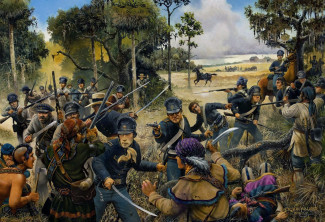
Johns Hopkins UniversityEst. 1876
America’s First Research University
Malaria and War in the Age of Jackson with C.S. Monaco

Among the many unexpected findings that I uncovered while researching my book on the Second Seminole War (1835-1842), the most startling was the major role of malaria. Previous historians of this often-marginalized war have focused on traditional wartime issues: from the weighty decisions of generals to the fighting ability of enlisted men and militia. Disease has never figured highly on anyone’s list of historical priorities. And, as implausible as it may seem, the subject of malaria is almost completely absent from the historiography. Such a basic omission has created, as one can imagine, a distorted view of this Jacksonian era war.
Since malaria is no longer active in the United States, it is easy to forget the devastation it once wrought. On the Florida battlefield, it brought on a special set of horrors. When I began my research, I was perplexed about the number of officer suicides, until I realized that they were all fighting amid a raging malaria epidemic. Because most men hailed from more northern latitudes, they were especially vulnerable to this disease since they had no prior immunity. Anyone who is familiar with malaria knows that the strain that does the most damage to both body and mind is Plasmodium falciparum. Psychosis, depression, cognitive deficits, and delirium frequently occur, and mortality is very high. True to expectations, I found that this deadly strain was well-established in nineteenth-century Florida and was thus the prime culprit in the rash of mysterious suicides.
Consider the case of Colonel John F. Lane during the harrowing summer of 1836. An officer still in his twenties, Lane complained of “great distress in his head,” before he suddenly committed suicide. He placed the hilt of his sword on the ground while he was alone in his tent and calmly ran the point through the corner of his eye into the brain, killing him instantly. Lane was a favorite of President Andrew Jackson and was considered one of the army’s rising young stars, so news of his death quickly traveled throughout the ranks. A detail that has often been overlooked is the fact that a surgeon who was attached to Lane’s regiment was alarmed over Lane’s behavior prior to his suicide. The colonel had acted very strangely for several days and was in an agitated state. Moreover, “his face was flushed, gestures rapid, voice stridulous and eyes restless.” His fellow officers assigned the cause of death to “a fit of insanity produced by brain fever.”

In addition to Lane’s passing, Lieutenant Thompson Wheelock, another West Point graduate who had gained a gallant reputation that same summer, also committed suicide. Soon after returning to his quarters, Wheelock used a pistol to fatally shoot himself through the mouth. Like Lane, Wheelock also exhibited peculiar behavior, and, in addition to fever, he began talking incoherently before his final act. Given the symptoms described, as well as the fact that both incidents occurred during a raging malaria epidemic, I easily surmised that neurological complications from malaria were almost certainly a major factor in both cases and that combat stress exacerbated the situation.
I also noticed that some men were susceptible to severe mental breakdowns and needed to be physically restrained during battle. A young soldier became so gripped with fear during an Indian attack, especially when the jarring sound of war whoops was at its highest, that “he became quite a maniac,” according to a hospital steward. The soldier died shortly after being tied down to the hospital floor. The medical staff assigned this case as “death from fright,” although another more plausible explanation would be falciparum malaria. The army’s own treatment regimen, which included mercury-laden medicines and painful blisters to the head, almost certainly hastened this person’s demise.
All these events occurred during a time when germ theory was unknown, and physicians adhered to medical dictates that could be traced to Hippocrates (400 BCE). For example, the ancient axiom of sustaining a balance of the four humors—blood, phlegm, black bile, and yellow bile—was a mainstay of medical training. As far as the state of army medicine was concerned, the Second Seminole War had more in common with the War of 1812 than the Civil War. One bright spot, as I discovered, was the introduction of quinine sulphate as a treatment for malaria mid-way during the conflict. The effectiveness of this practice had been established by the French army in Algeria several years earlier, and news of this development appeared in American medical journals. After its success in Florida, the surgeon general’s office claimed that high doses of quinine “would revolutionize the treatment of fever in this country.” Indeed, the army medical department began using quinine as a mainstay in future wars and it became accepted among the general public as well.
C. S. Monaco is a courtesy professor of history at the University of Florida. He is the author of Moses Levy of Florida: Jewish Utopian and Antebellum Reformer and The Rise of Modern Jewish Politics: Extraordinary Movement. Most recently he is the author of The Second Seminole War and the Limits of American Aggression


